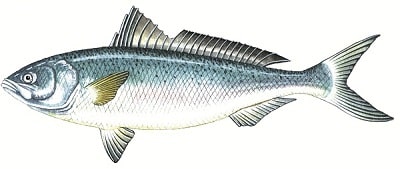Genus Arripis spp.
Description
Australian salmon have a rounded body with a large forked tail. The sides of the fish are silvery and the back is a dark bluish-green colour with black spots. The underside is white. The pectoral fin is small and yellowish in colour. Juveniles display dark vertical bands and yellow spots on their sides.
Distribution
Australian salmon are a pelagic species of fish which travel in schools and can cover long distances. Adult fish can be found around inshore reefs in the bays and also along adjacent coastal beaches. Juvenile Australian salmon prefer the sheltered waters of estuaries.
Size
The size of Australian salmon caught in the Port Phillip region varies considerably from juvenile fish of 200 g or less in estuaries, through to schooling adult fish of between 700 g and 2 kg around the inshore reefs of Port Phillip Bay. Occasionally larger fish of 3kg or more enter the bay.
Fishing techniques and tackle
Small to medium sized Australian salmon can be caught from many piers using a variety of baits. Various rigs can be used including a running sinker or paternoster rig, or fishing with a float. Australian salmon respond well to metal lures which are cast out and retrieved. When schools of Australian salmon are present in the bay they can be located by looking out for flocks of sea birds that are diving and feeding. Once a school of fish is located they can be caught by trolling lures in their vicinity or casting lures, flies or soft plastics. When hooked Australian Salmon put up a strong fight, often jumping clear of the water several times.
Baits
Australian salmon can be caught on most common baits including pilchards, whitebait, pipies and squid. Silver metal lures of various weights are very effective.
Locations
Small to medium-sized Australian salmon are commonly caught from many of the piers in the Port Phillip region. Piers worth trying include those at Portsea, Flinders and Queenscliff. In the northern part of Port Phillip Bay schools of salmon often appear over the reefs at locations such as Black Rock, Beaumaris, Williamstown and Point Cook.

Sustainable fishing techniques
- Hook damage is the most significant cause of fish dying after being released. Deep-hooked (gills, gut) fish are far less likely to survive.
- Fish with a tight line so that fish are less likely to swallow the hook.
- Increase the size of your hooks to prevent small fish swallowing them.
- Avoid suspending fish on the hook.
- Fish hooked in the mouth or lip have the best chance of survival.
- Remove the hook with long nosed pliers.
- If you can’t see the whole hook protruding from the mouth of the fish don’t try and remove it.
- Cut the line and release the fish.
- Wet your hands before handling the fish.
- Avoid touching the gills and eyes.
- Return the fish as quickly as possible.



